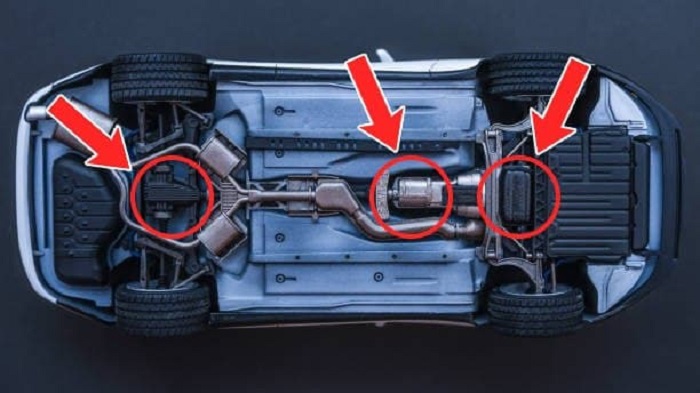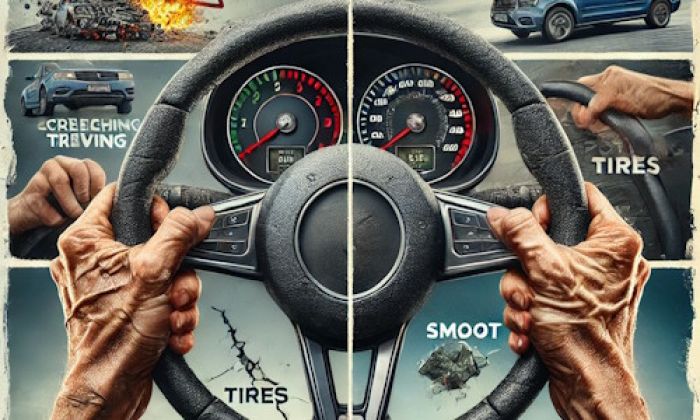Oil leak is the result of problems with some parts of engine, transmission, AC system or steering system. Oil can also leak from different parts of the car, and today we'll look at the problem thoroughly.
It's not a good idea to ignore those black puddles of oil under your vehicle. Over some time, this can lead to low oil level, major leaks or bad breakdowns. Minor oil leaks are possible to stop temporarily, but in majority of cases you will still need to consult the service station specialists.

Today we'll find out the reasons, consequences, ways to fix the oil leaks of different types.
Where does oil leak from in a car?
There are several units that can cause an oil leak in your car:
- Engine.
- Transmission.
- Steering system.
- Air conditioner.
- Shock absorbers.
- Differential.
Also, you may have seen other liquids and thought it was oil. For example, brake system can have leaks of brake liquid and cooling system may have leaks of antifreeze.
The number of units that have oil in a car may be different according to the vehicle's equipment. Every unit that has oil inside, may be the reason of leaks.
Engine oil leaks - main reasons
In majority of cases the oil leaks are connected with engine. This unit is one of the most loaded in the car, and the amount of oil in the engine is quite big. Also, there are a lot of places where the engine can show a leak.
If you suspect the engine oil leak, check these parts:
- Oil pan gasket. Oil pan is places under your car's engine. After lubricating the engine, the oil comes here and rests until you start the engine again. The gasket can be worn out, and this will cause leaks.
- Valve cover gasket. The valve cover is located on the top of the engine. Its gasket holds the hot oil inside when it lubricates the valves. If the gasket is worn out, you'll see lines of oil going down your engine.
- Oil filter. In different engines the filter may be placed in different spots. Find it and check if there are no oil leaks that are visible. The place of mounting the filter should be dry.
- Oil drain plug. Usually, the plug is visible from beneath the car. Check if it's dry and there are no visible leaks around the plug.
- Crankshaft and camshaft seals. To check the crankshaft and camshaft seal leaks, you will need to consult the service station workers. These are internal parts of the engine, so it's hard to see how these seals are doing in your car.
- Cylinder head gasket. Well, if this gasket brakes, you will have quite a lot of troubles with internal leaks. But in some kinds of engines like Subaru boxer engines, the cylinder head gasket may also leak externally.
- Timing cover gasket. If your car has a chain in timing system, the timing cover may give some leaks. The chain is lubricated with engine oil, so if the gasket is broken, the oil will leak.
- Oil filler cap. The cap should close the oil filler in the needed way. If it's broken, some drops of oil may leak. But if the oil filler cap leaks heavily, you should check the engine - it shouldn't pump a lot of oil to the area of the cap.
- Oil dipstick. Usually, there is no danger of oil leaks through the dipstick. But if the engine works with some breakdowns or with bad oil, it can cause oil leaks through the oil dipstick hole.
Also, there are other spots where you can see the oil leaks. For example, there were Volkswagen engines that were known to leak oil through crankcase ventilation system. Here, Wiki writes about this.
How to say that your car has oil leaks?
It may seem easy for you, but it's not always that you find those scaring black puddles under your vehicle. The leaks may be minor, so all the oil can remain on the engine and burn when you drive.
There are 4 major signals that show oil leaks in your car:
- The smell of burning rubber when you drive. As soon as the engine is hot enough, the leaked oil starts burning, and usually you can smell the burning rubber inside the vehicle.
- Low oil level. Use the dipstick more often to check the oil level. If it gets lower, there are two possible things happening: the engine is broken and starts burning oil, or there are some leaks.
- The oil pressure light. If you see the oil pressure light turning on, it's now the best time to stop your car and to stop engine. If it continues working with low oil pressure, there are big risks for engine to be dead soon.
- Some parts under the hood of your car are covered with oil. Sometimes oil leaks are visible only when you look thoroughly to the engine and different parts in the front of your vehicle.
How to fix oil leak in a car?
To fix an oil leak, you'll need to find the reason first. Then the best decision will be to take your car to service station and have it repaired.
Depending on the problem type, it will take from 1 hour to 2 working days to deal with the leak. If the case is too difficult, more time may be needed.
There are some cases when you may repair the car by yourself. For example, if the oil filler cap is broken, you may buy a new cap in the internet and just install it by yourself.
If you are on the road and you noticed that there is a leak, you may try to fix the leak with any methods to just continue driving. If the leak is minor, just check the oil level in the engine and keep driving. Stop sometimes to check the oil level again to ensure that everything is safe. But it's recommended to change your route and go to the nearest service station to examine the car and find the real reason of the leak.
How bad is oil leak for a car?
Oil leaks are very dangerous for engine, transmission or any other part that has oil inside. Once the oil level is lower than needed, the unit starts wearing out intensively. If you don't react and keep driving, the problems may be devastating.
So, the possible consequences of oil leaks are as follows:
- low level of oil in engine, transmission and other units which causes faster wear;
- fire risk because oil can start burning when heated to a certain temperature;
- engine overheating - if the oil covers the external part of engine, it will cause higher working temperature;
- ecology issues - oil leaks help oil get into the nature and destroy ecosystems;
- oil puddles on your driveway and in garage that will be hard to clean.
So, yes, the oil leaks are really bad for your car in many ways, and you better do something with them.
Why does oil leak when I add new oil into the engine?
In majority of cars, it's not convenient to add new oil through the oil filler. The filler is located on the top part of the engine, but there are many other things around, so it's quite hard to pour some oil without spreading it all over the engine. And even if you are very careful, some drops will get on the external part of the engine.
After some time, these drops will go down and form a small black dot under your car. If it happens, pay more attention to the way you add oil into the engine. Also, after you notice the black drops under your car, pay more attention to possible leaks for a couple of days.
What does it mean if you have no oil in engine with no leak?
Leaks in engine aren't the only way the oil can disappear. In old engines and also in engines with bigger capacities the oil burns within the process of work. You may read manuals for your type of engine and see if the producer states the normal amount of oil that can be burnt in every 500 miles. Guys from Cars.com write about normal oil burn in their article, and we don't know what should we add.
If your engine starts burning too much oil, you will need to look at valve guides or piston rings. It may be that the engine needs repair.
About the authors
The CarAraC research team is composed of seasoned auto mechanics and automotive industry professionals, including individuals with advanced degrees and certifications in their field. Our team members boast prestigious credentials, reflecting their extensive knowledge and skills. These qualifications include: IMI: Institute of the Motor Industry, ASE-Certified Master Automobile Technicians; Coventry University, Graduate of MA in Automotive Journalism; Politecnico di Torino, Italy, MS Automotive Engineering; Ss. Cyril and Methodius University in Skopje, Mechanical University in Skopje; TOC Automotive College; DHA Suffa University, Department of Mechanical Engineering






Add comment